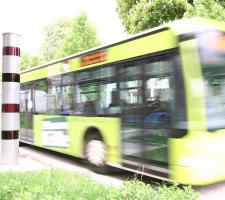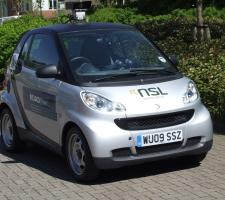
By using a high-resolution camera to monitor more than a single lane, the Siemens LaneHawk system automates enforcement of both full and partial infringements into bus lanes.
RSS
In the last few months,189 Siemens in the UK has unveiled LaneHawk, an automated, digital Automatic Number Plate Recognition (ANPR) system specifically designed for the enforcement of bus lanes. The Traffic Management Act (2004) enabled English local authorities outside London to apply for the powers to decriminalise bus lane enforcement. Siemens felt this presented an opportunity to launch a new, ANPR-based system which could fulfil the enforcement task economically and effectively, says Mark Bonnor-Moris, Business Manager - Enforcement Systems.
Local authorities within London had previously used either operator-controlled CCTV-based systems or fixed, analogue systems based on VHS (video) technology. The CCTV-based systems required authorities to have an existing CCTV infrastructure. The analogue fixed systems, meanwhile, produced low-quality images and were manpower-intensive.
The LaneHawk outstation consists of an ANPR reader that uses a high-resolution digital camera to capture images of vehicles entering the monitored zone. The images are then processed to determine the vehicle's registration number while a separate colour camera provides contextual video which removes any ambiguity as to a vehicle's movement.
The vehicle registration number is checked against a white list which is compiled by the customer and downloaded to all outstations. If it is not an authorised vehicle the images and sighting text information are amalgamated into an evidential record. Evidential records are automatically sent from the outstation to the Evidential Record and Control Unit (ERCU) over Digital Subscriber Line (xDSL) or Local Area Network (LAN), usually hosted at the customer's premises. Operators then use the LaneHawk review station to review each evidential record; including ANPR image, context video and data block.
"The vast majority of ANPR enforcement systems use single-lane cameras," says Bonnor-Moris. "LaneHawk uses a high-resolution CRS-supplied Hawk ANPR camera, this enables the system to enforce one and half lanes of traffic with a single camera. This is a significant benefit for bus lane applications, where it is important to be able to capture the registration number of vehicles which are only partially entering the lane and blocking buses' passage."
LaneHawk is sold, installed and commissioned as a complete enforcement system. LaneHawk is supplied with the ERCU and LaneHawk Review Station which means it can be installed and operated without having to register or approve any existing third-party software or equipment. The only interface required is for the contravention data created by LaneHawk; this will easily integrate with customers' existing parking back office systems for processing Penalty Charge Notices (PCNs).
"Tests have been very positive in terms of system operation and ANPR trigger and capture rates," he continues. "These have been on-site at our own facilities but a trial site which was installed in the town of Chelmsford, Essex in April was accepted by the local county council in June. Live enforcement is planned for the next few months."
662 SEA's ANPR-based ROADflow is currently the only fully automated mobile parking enforcement system deployed in England - if not the world, according to the company's Don Turner.
"There is a Smart Car-mounted mobile system on the market already but it's manually operated. That often means having two operatives in the vehicle and having to stop to adjust or operate the camera and to manually record offences. Whilst it's a good system which has been available for about seven or eight years, the market has moved on and recognised there are efficiency savings to be made. Our system gives a vehicle which is driven by a single enforcement operative the ability to record offences without having to stop."
ROADflow can currently enforce anywhere where there are restrictions on parking or driving. It has a full onboard PC and is able to intelligently use white/blacklists to work out whether or not to ignore a vehicle or event. As appropriate it makes up an evidence pack and the decision over whether or not to prosecute is taken in the back office.
ROADflow features onboard GPS. SEA also programmes it with the locations of all traffic regulation orders (yellow lines, bus stops, school entrances, residents' parking bays and so on). The roof-mounted, dual-purpose (colour context and InfraRed (IR) illumination) ANPR camera is triggered when a vehicle is spotted and the onboard computer deduces that it is in an area where parking is not permitted. The preceding 15 seconds of recording is retained from a buffer memory and the system carries on recording for a further 15 seconds to provide a unique, 30-second video clip which places the offending vehicle in context. An evidence pack contains 150 JPEGs (30 seconds at 5fps), all of which are date/time/location-stamped. It also includes metadata with an offence code, along with the IR image of the plate which triggered it. This is encrypted when it is taken from the vehicle via a memory stick or wirelessly and is de-encrypted when it is loaded into compatible back offices to enable licencing checks to be carried out and, if necessary, PCNs to be issued.
"We will shortly be shortly deploying a cashless parking interface," Turner continues. "Our vehicle will ignore parked cars that have paid for spaces but it will record where a cashless parking service provider fails to inform us that the driver has paid; there is a built-in double-check facility to recognise late payers.
"Other applications being developed include timed bay enforcement, cashless parking solutions and further police surveillance-type applications such as the use of video analytics software with fixed cameras which seamlessly and wirelessly download evidence packs to the vehicle."
The system was created as a proof of concept which would allow Transport for London (TfL) to effectively patrol its red (no stopping) routes.
"TfL has used our system for three years and data is readily available," says Turner. "We have recently sold the system to local authorities in England. Bournemouth Borough Council went live on 17 June 2009 and initial results are very good indeed. Basildon District Council has just received certification for its system and will be going live very shortly. More systems are currently being fitted out for other customers and it is now being marketed worldwide."
147 Vitronic's PoliScanspeed system to solve the problem of restricted-access streets being used by prohibited drivers.
The LIDAR-based PoliScanspeed was chosen over the company's other product offerings both for the speed and ease with which it could be adapted to its new role and because it allowed the flexibility of also using the camera system in its original speed enforcement role, says the company's Adrian Wilkinson.
"The adaptation required for the project was extremely small," he says. "We simply programmed the PoliScanspeed system to capture all vehicles travelling at faster than stationary. A case file, as produced with regular PoliScanspeed systems, is created and sent to the back office for evaluation. Buses and taxis are filtered out and violation notices are sent to offenders. If a vehicle - bus, taxi or other - is found to be breaking the set speed limit a notice is also sent.
"The system was installed in April this year. In its first four weeks it recorded almost 3,200 violations and as the system's presence has become more widely known this has dropped to around 200 violations per week. Local residents are especially appreciative of the increased safety the installation has brought about; as the section of road involved is reserved for public transport, drivers would often cut through at great speed in an attempt to avoid being caught. This no longer happens."
LIDAR (LIght Detection And Ranging) offers several advantages, he continues.
"Each system can track vehicles on up to four lanes, although the solution being used in Wiesbaden enforces only on two. Many systems also require loops, other in-road sensors or light barriers to detect that a vehicle is present, which PoliScanspeed does not. PoliScanspeed is less time and cost-intensive to install, therefore, and traffic flows are uninterrupted.
"The City of Wiesbaden has estimated that the system installed will amortise its costs in approximately three months. The authorities there have been delighted with the results and as a result of positive press Vitronic has had enquiries from other cities wanting to install the system. As a combined speed and lane enforcement device, this has the potential to impress authorities worldwide but we're still deciding where to market this product. Most large cities now have special lanes for buses, taxis or high-occupancy vehicles so the potential market is relatively large."RSS
Across the board, technology is being brought to bear to improve the efficiency of enforcement. Bus lane monitoring, parking and controlled access have all benefited from systems introduced in recent months.
While speed and red light infringements tend to attract the most attention, there remain several other areas of enforcement where automation can bring significant operational and efficiency benefits. Lane monitoring and access control also continue to benefit from technological development.In the last few months,
Local authorities within London had previously used either operator-controlled CCTV-based systems or fixed, analogue systems based on VHS (video) technology. The CCTV-based systems required authorities to have an existing CCTV infrastructure. The analogue fixed systems, meanwhile, produced low-quality images and were manpower-intensive.
The LaneHawk outstation consists of an ANPR reader that uses a high-resolution digital camera to capture images of vehicles entering the monitored zone. The images are then processed to determine the vehicle's registration number while a separate colour camera provides contextual video which removes any ambiguity as to a vehicle's movement.
The vehicle registration number is checked against a white list which is compiled by the customer and downloaded to all outstations. If it is not an authorised vehicle the images and sighting text information are amalgamated into an evidential record. Evidential records are automatically sent from the outstation to the Evidential Record and Control Unit (ERCU) over Digital Subscriber Line (xDSL) or Local Area Network (LAN), usually hosted at the customer's premises. Operators then use the LaneHawk review station to review each evidential record; including ANPR image, context video and data block.
"The vast majority of ANPR enforcement systems use single-lane cameras," says Bonnor-Moris. "LaneHawk uses a high-resolution CRS-supplied Hawk ANPR camera, this enables the system to enforce one and half lanes of traffic with a single camera. This is a significant benefit for bus lane applications, where it is important to be able to capture the registration number of vehicles which are only partially entering the lane and blocking buses' passage."
LaneHawk is sold, installed and commissioned as a complete enforcement system. LaneHawk is supplied with the ERCU and LaneHawk Review Station which means it can be installed and operated without having to register or approve any existing third-party software or equipment. The only interface required is for the contravention data created by LaneHawk; this will easily integrate with customers' existing parking back office systems for processing Penalty Charge Notices (PCNs).
VCA certification
It is currently the only system of its type with UK Vehicle Certification Agency (VCA) certification. This enables Siemens to install and commission systems without the need for enforcement authorities to seek further approval from the VCA. It also removes the requirement for authorities to provide detailed technical construction file information to the VCA, reducing the cost of implementation and the time taken to start enforcement; Siemens simply completes a two-page pro-forma and registers each new LaneHawk system with the VCA. Where appropriate, Bonnor-Moris says, the company will also market the system in other countries."Tests have been very positive in terms of system operation and ANPR trigger and capture rates," he continues. "These have been on-site at our own facilities but a trial site which was installed in the town of Chelmsford, Essex in April was accepted by the local county council in June. Live enforcement is planned for the next few months."
Mobile parking enforcement
"There is a Smart Car-mounted mobile system on the market already but it's manually operated. That often means having two operatives in the vehicle and having to stop to adjust or operate the camera and to manually record offences. Whilst it's a good system which has been available for about seven or eight years, the market has moved on and recognised there are efficiency savings to be made. Our system gives a vehicle which is driven by a single enforcement operative the ability to record offences without having to stop."
ROADflow can currently enforce anywhere where there are restrictions on parking or driving. It has a full onboard PC and is able to intelligently use white/blacklists to work out whether or not to ignore a vehicle or event. As appropriate it makes up an evidence pack and the decision over whether or not to prosecute is taken in the back office.
ROADflow features onboard GPS. SEA also programmes it with the locations of all traffic regulation orders (yellow lines, bus stops, school entrances, residents' parking bays and so on). The roof-mounted, dual-purpose (colour context and InfraRed (IR) illumination) ANPR camera is triggered when a vehicle is spotted and the onboard computer deduces that it is in an area where parking is not permitted. The preceding 15 seconds of recording is retained from a buffer memory and the system carries on recording for a further 15 seconds to provide a unique, 30-second video clip which places the offending vehicle in context. An evidence pack contains 150 JPEGs (30 seconds at 5fps), all of which are date/time/location-stamped. It also includes metadata with an offence code, along with the IR image of the plate which triggered it. This is encrypted when it is taken from the vehicle via a memory stick or wirelessly and is de-encrypted when it is loaded into compatible back offices to enable licencing checks to be carried out and, if necessary, PCNs to be issued.
"We will shortly be shortly deploying a cashless parking interface," Turner continues. "Our vehicle will ignore parked cars that have paid for spaces but it will record where a cashless parking service provider fails to inform us that the driver has paid; there is a built-in double-check facility to recognise late payers.
"Other applications being developed include timed bay enforcement, cashless parking solutions and further police surveillance-type applications such as the use of video analytics software with fixed cameras which seamlessly and wirelessly download evidence packs to the vehicle."
The system was created as a proof of concept which would allow Transport for London (TfL) to effectively patrol its red (no stopping) routes.
"TfL has used our system for three years and data is readily available," says Turner. "We have recently sold the system to local authorities in England. Bournemouth Borough Council went live on 17 June 2009 and initial results are very good indeed. Basildon District Council has just received certification for its system and will be going live very shortly. More systems are currently being fitted out for other customers and it is now being marketed worldwide."
Controlled access
On Willy-Brandt-Alle in Wiesbaden, Germany, local authorities are using a version ofThe LIDAR-based PoliScanspeed was chosen over the company's other product offerings both for the speed and ease with which it could be adapted to its new role and because it allowed the flexibility of also using the camera system in its original speed enforcement role, says the company's Adrian Wilkinson.
"The adaptation required for the project was extremely small," he says. "We simply programmed the PoliScanspeed system to capture all vehicles travelling at faster than stationary. A case file, as produced with regular PoliScanspeed systems, is created and sent to the back office for evaluation. Buses and taxis are filtered out and violation notices are sent to offenders. If a vehicle - bus, taxi or other - is found to be breaking the set speed limit a notice is also sent.
"The system was installed in April this year. In its first four weeks it recorded almost 3,200 violations and as the system's presence has become more widely known this has dropped to around 200 violations per week. Local residents are especially appreciative of the increased safety the installation has brought about; as the section of road involved is reserved for public transport, drivers would often cut through at great speed in an attempt to avoid being caught. This no longer happens."
LIDAR (LIght Detection And Ranging) offers several advantages, he continues.
"Each system can track vehicles on up to four lanes, although the solution being used in Wiesbaden enforces only on two. Many systems also require loops, other in-road sensors or light barriers to detect that a vehicle is present, which PoliScanspeed does not. PoliScanspeed is less time and cost-intensive to install, therefore, and traffic flows are uninterrupted.
"The City of Wiesbaden has estimated that the system installed will amortise its costs in approximately three months. The authorities there have been delighted with the results and as a result of positive press Vitronic has had enquiries from other cities wanting to install the system. As a combined speed and lane enforcement device, this has the potential to impress authorities worldwide but we're still deciding where to market this product. Most large cities now have special lanes for buses, taxis or high-occupancy vehicles so the potential market is relatively large."RSS













